Threshfield and Low Baildon Walk
This is one of the walks within the Heritage Walks created by Baildon History Society and commissioned by Baildon Parish Council.
Threshfield and Low Baildon Walk
(Distance: 3.5 miles or 5.5 km, approx – see note about distances at end)
This walk takes you all along Station Road and back, giving glimpses of both clothiers’ cottages and grand houses of later mill owners. This Guide starts outside Brook Hill Stores, but you can begin at the other end, from the Threshfield heading on page 10.

Brook Hill
Before the opening of the station on December 4th 1876, Station Road was known as Low Baildon Road. This area near Brook Hill was once known as Low Baildon, and is still shown as such on many maps. Kirklands Road and Station Road both used to be old lanes. The latter was part of the medieval route known as Idlegate which led down to the River Aire, forded at Buck Lane, and on to Idle (see Riverside Walk). A branch off what is now called Roundwood Road (a continuation of Station Road) led to Esholt.

The Brooks after whom the area known as Brook Hill is named, were an old Baildon family of clothiers. Cloth making became the staple industry in Baildon from C17th, and clothiers such as the Brooks of Brook Hill built themselves houses where they did hand spinning and weaving, and usually owned land nearby which they farmed, as the Brooks did. These were early capitalists who bought wool and sold cloth, paying others to spin and weave by hand in their own cottages (the domestic system) as well as producing for themselves. Wealthier clothiers like the Butlers of Butler Lane had a workshop for looms attached to the house (see Baildon Village Walk).
The first Brooks to arrive here were John Brook, a tanner from Tong, who in 1612 bought a messuage (house, outbuildings and yard, possibly garden) from the Lord of the Manor Gervase Fitzwilliam (i.e., son of William) who was selling up. John also bought from him another house, barn and buildings plus the croft adjoining called Hobbutt (we shall pass Hop Butt, as it is now called, later). In the same year a Samuel Brook also bought a messuage with barns, garden and a lot of land from Fitzwilliam.
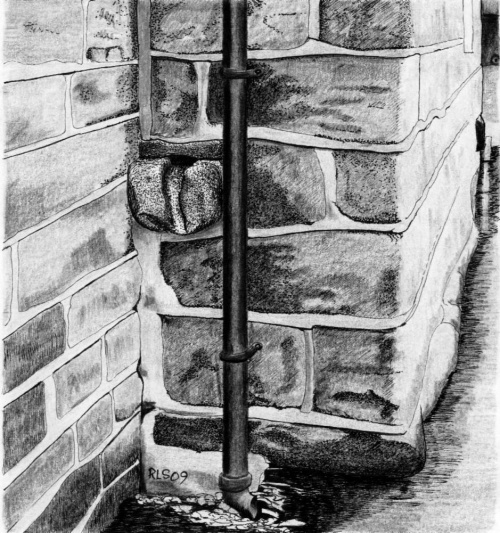
Brook Hill Stores is the original ‘Brook House’, built in 1718 for Thomas and Ann Brook. It is a Grade II listed building as are some of the cottages nearby. As you walk past the front of the shop, note on the adjoining cottage a stone lant spout (between the down pipe and the inside corner of the wall). Lant is an old Yorkshire word for urine, which was collected in a tub through the spout and used in scouring cloth.
Pause at the corner of the building at the start of the cobbled track. Here there used to be a tiny shop. People can still remember as children being allowed to weigh out potatoes and other goods on ordinary kitchen scales, as the shopkeeper (Miss Dale, and after her Mr Reid) sat on a stool amidst all their wares.
From this cobbled lane a little farther along, look back at the rear of what was the first Brook House (Brook Hill Stores), to see a datestone and the initials of Thomas and Ann Brook TBA 1718. It’s just below the little circular window.

There used to be outbuildings which at one time acted as a weaving shed and a brewery: a deep well with a pump supplied the water. Inside the house there is an original stone fireplace in a large arch which is thought to have been put in by the same stone mason as put in a fireplace at Kildwick Hall. Continue straight ahead and you will pass a short row of quaint old cottages and some houses on your left before you reach the top of Brook Hill which is a steep grassed area of open common land (and a traditional sledging ground in winter).
Turn left and walk along the top of the hill to see three more quaint cottages, all listed, then return to the path at the top of Brook Hill. From the upright stone at the top of the path you will have a wonderful view (foliage willing) across the valley to Thackley with the old converted Brackendale mill on your left and the new housing estates of Cote Farm and High Busy Lane. Walk carefully down the steep path to the bottom of the slope (there is a handrail if necessary – if nettles and brambles permit).
The house at the bottom of the path on the corner next to the two snickets is the present Brook House. Through the short snicket on the right there was once a pig farm before the new houses were built as part of the Woodbottom Estate in the 1930s. (The other snicket, past the side of the house, would take you down to Charlestown.) Brook House was built in 1765. It is one of a row of odd numbered cottages. What were formerly Nos 1 and 3 Brook Hill, have now been made into Brook House.

The Brook Hill Estate was sold by auction in nine lots in 1831 following the death in 1830 of John Brook, a Brook Hill farmer. Two of the lots were bought by John Rhodes, a Shipley farmer. They included New Close and a piece of land called the Rocks, which were at the end of the long Charlestown snicket – at the top of Fyfe Lane (now Upper Fyfe Lane). John Rhodes paid £1,115 for the land. He was the father of Mercy Rhodes who married James Fyfe, and the land passed into the Fyfe family after whom Fyfe Lane is named. (See Charlie Thompson Walk.)
Behind Brook House there is a large garden including the remains of an orchard which extends behind the row. At one time there was an old-fashioned ‘refridgerator’ in the garden – a hole in the ground for storing meat, which was covered with a neatly cut rectangular stone with a perfectly round hole in the middle which would have been covered with a wooden lid. Only the stone top remains and has been carefully re-used as part of the building. Formerly weavers’ cottages, the windows give plenty of light and there is a window seat where the weaver could sit. The house has since been extended, and at one time it included a billiard room.
Mary and Roger Evans lived there from about 1990. Before them were the Gibsons, and before them a woodworker called Bannister who moved a staircase and also made crossbows! During World War II it was owned by a major who rented it out, and one pair of tenants were women who gained a bad reputation. They entertained rather a lot of servicemen and had to be evicted. At another time it was a school. It is said to have been one of the properties sold by James Theodore Bent to finance his trip to Zimbabwe to visit the ruins in Mashonaland in 1890/91. At the other end of Brook House are some outbuildings which in the past would normally have included privy and ash pit, probably for several houses.

Walk along the track past the row of cottages until you reach Kirklands Road, which used to be called ‘Slaughter Lane’. Here in the days of Robert the Bruce in C14th, it is alleged, marauding Scots swept down from the north and butchered fleeing Baildonians! It was still called Slaughter Lane in building plans presented to Baildon UDC (Urban District Council) in 1899. Renaming it to Kirklands Road reflects later sensitivities.
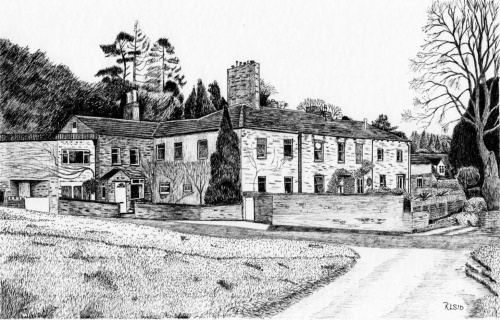
Opposite you will see the large house Ingfield, Grade II listed and built c.1770. The word ‘ing’ means meadow. A little farther down Kirklands Road, on this side, are some houses called Ings View. Ingfield had malt kilns for making beer up to the first half of C20th, and was at one time supplied with hops from Hop Butt which we shall pass later. It is now a short terrace of cottages with some new houses near. During the second world war it housed an ARP (Air Raid Precautions) post in the cellar. Margaret Wood was an ARP messenger, and recalls that whenever the warning sirens went, if not already on duty, she had to hasten there by bicycle and take any messages to HQ in Baildon Town Hall in Rushcroft Terrace, which we shall see later.
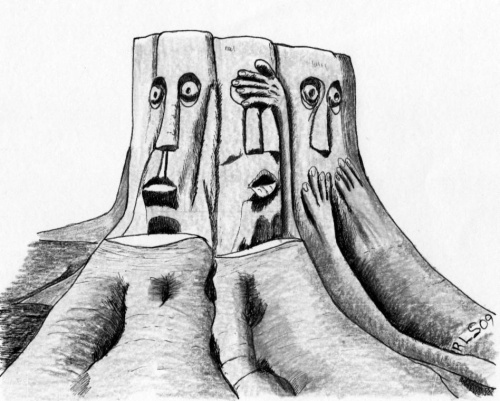
Turn left and walk up to Station Road. Notice in passing behind some railings the carving of the three wise monkeys (‘see no evil, hear no evil, speak no evil’) in the huge stump of a once-mighty beech tree, in the last garden before you reach Station Road.
On the opposite side of Station Road is Baildon House which dates back to 1724. We shall pass it again later, but this is the best place to see it from. It is Grade II listed, and was built for the Holdens who owned a lot of land in the area. Difficult to see behind trees, it has a datestone with the inscription 1724 at the front. The initials RH stand for Robert Holden.

From Brook Hill to Threshfield
Turn left along Station Road and pass Brook Hill Stores and the cobbled track. On the left you will see Elmfield (Nos 27 and 27a – illustrated at the beginning of this Guide), another Grade II listed C18th building with features dating back to the C16th, which was once a farm. It was linked with William Baildon senior who lived here until his father, a Robert Baildon, died in 1599. William then moved to Baildon Hall. There are two inscriptions: WB 1593; and also JAL 1715 for John and Anne Lambert. Both inscriptions are on the front of the house, so they cannot be seen from the road, but the word ‘dairy’ can still just be seen from the pavement, written above a window on the part of the building which juts out towards the pavement. It is now two houses. Just after the war the weekly rent for No 27a was 6/- (30p).
Through the arch at Elmfield there were four cottages. At about the time of the second world war, in one of these cottages lived a lady called Mary who assiduously collected horse dung from Station Road for her rhubarb. Her pies are still remembered! In another lived the Bancrofts who kept goats – there were fields which stretched right down: their son ran Bancroft Cards in Bradford and Shipley. A rag and bone man kept his horse in a barn which was later demolished to build the adjacent bungalows. And there was a man called Dick who is remembered chopping firewood on his kitchen table. Farther along you reach Hop Butt (with the bushes between it and the road). This row of houses and cottages – there were nine here in the census of 1841 – was so called because hops were grown nearby. It is said these were used for brewing beer at Ingfield, which we have already seen. The word ‘butt’ is an old one which can have several meanings: a place for archery practice from the days when the long bow was in use; or a short strip of arable land. Margaret Wood, who lived in Hop Butt during the second world war, remembers that if you had empty bedrooms you had to take evacuees; and a mother, two children and a granny were evacuated to her house from Hull, and stayed two years. (During that time (1939-45) if you lived within five miles of Bradford you could be evacuated. Baildon was just outside that limit, and so had to take them.)
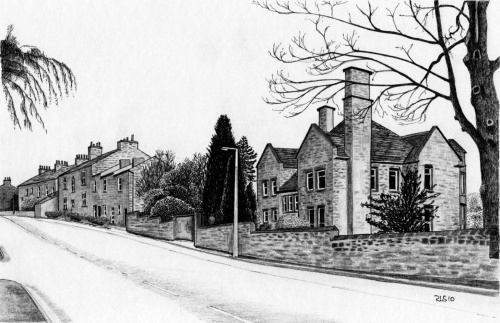
After Hop Butt you reach a large imposing building with the name Baildon Manor on a plaque by the entrance. However, this is a very recent renaming, and indeed the name of this building has changed several times. On the 2015 and 2008 electoral rolls it is called Beck House, but on the 2012, 1990 and and 1974 rolls it appears as Barnsley Beck. Kelly’s Directory of 1936 lists it as Enfield, but gives it no name in 1924. Further, some sources record that until just after the second world war, it was called Netherfield. In 2007 it was up for sale, and the estate agent’s colour brochure described it as an early C20th house built in the Arts and Craft Style in about 1914 as a doctor’s house and surgery. Kelly’s 1924 Directory lists this doctor as Dr Edwin G Firth, LRCP, a London physician and surgeon, and the 1936 edition records that he was medical officer of health to Baildon UDC. In those days no appointments were necessary: patients came during surgery hours and waited their turn.
When Dr Firth retired his two daughters, the Misses Firth, set up a private school. There were two classrooms and a small kitchen and toilet on the ground floor for between 15 to 18 pupils. The playground was part of the garden. June Sorge, a Baildon resident, remembers that it was a happy school with well-behaved children, and the most famous pupil was Richard Whiteley, of TV renown: ‘he was then 7-8 years old, a quiet boy with long eye lashes.’
Beck House (now Baildon Manor) was named after Barnsley Beck, which is still there but now flows underground by the back of the houses in Netherhall Road. It can be seen only in a garden on the opposite side of Station Road, which we shall see later. A few steps farther on is Barnsley Beck Grove which leads down to where the hops (of Hop Butts) used to be grown. Later this was a garden centre called Woodward’s Nursery, but that has now closed. In days gone by, before all the houses were built in this area, it could be quite lonely: one man moved here from Manningham for the peace, but found it too isolated and went back again!
Just beyond Barnsley Beck Grove, where a snicket cuts down to the left, are some sheltered-housing bungalows called Netherhall Park. On this site there used to be a Council yard, where a horse, cart, brush and shovel were kept, under the care of one Tommy Bottomley. Kelly’s records that use in 1936, but in 1924 it is called Baildon UDC Mortuary. Adjacent to this site, stood an ancient house – John La Page describes it as a C17th building, though by the time he was writing (The Story of Baildon was published in 1951) it belonged to Baildon UDC and was much altered: older residents of Baildon can still remember it in a rather ruinous state – and, confusingly, it too was called Beck House, and appears as such on old maps (e.g., 1860 and 1920).
Now cross Netherhall Road. ‘Nether’ means low or lower, and ‘Netherhall’ is a reference to the nearby Baildon Hall, which we shall see later. Continue up the slope until you reach the cross roads at the end of Station Road where it joins Baildon Road (opposite is Cliffe Avenue). One Baildon resident remembers the Yorkshire Bus Company erecting the first bus stop at the end of Station Road. It was the 1d fare stage (less than ½p), which was the fare from Shipley to here. At that time buses turned at the bottom of Browgate, as they could not get up to Baildon.
Turn left past the post office and walk until you reach the semi-detached houses (No 87). Dr Penn held his surgery in a room of this semi where he lived. Patients entered through a door at the side of the house. He practised as a doctor there in the 1950s on his own, which was the norm until group practises became common later in the second half of the C20th. Mrs Birch, the funeral director’s wife, remembers having her ears pierced there by Dr. Penn.
Threshfield
Return to the pelican crossing and cross the main road to the terraced row of houses called Threshfield, which stretches along to Sandals Road.
The land here used to be arable fields according to the 1845/6 Baildon tithe map, and accompanying ‘award’, which probably explains the name. At that time there were 300 acres of arable land in Baildon for growing wheat, barley and oats. Much of the arable land was down by the riverside. One elderly Baildon resident remembered playing whip and top safely in the road here as a boy in the first half of the C20th. At that time he remembers there being only one car owner in Baildon, a Mr Waddilove, whose family we shall hear of again later. Baildon Road was made c.1748 and replaced Cliffe Lane as the main route to Shipley from Baildon.

From the pelican crossing, you can wander left along Baildon Road looking at Threshfield, with the name clearly visible above No 21, but then return past the pelican crossing to the to the end of Cliffe Avenue, opposite the shops at the cross roads, and turn up left past the bus stop, and the shops and doctors’ surgery on the other side of the road, and you will soon come to Old School Way. Cross over Cliffe Avenue here. New houses were built here at the start of the C21st in the grounds of what was Sandals School. (Old maps call this area Sandhills). The school itself, which was a primary school and then a first school, has been converted into apartments. The school first opened as a Board School in 1893. When the ground was dug for the school, a bronze age axe head was found. There is more about this area in The Ferniehurst and Baildon Green Walk (see inside back cover), and The Peace Walk, available from Baildon Community Link farther up Cliffe Avenue.
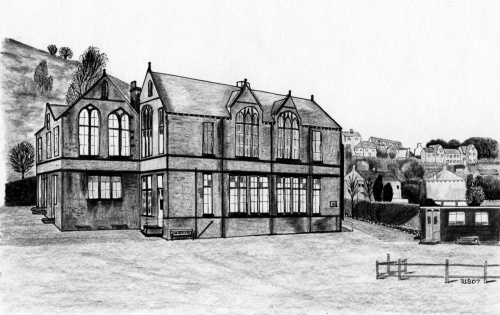
Return back down to the cross roads and turn left. Walk past the Co-operative Food Store and up Browgate as far as the row of tall stone houses on the left called Rushcroft Terrace. The land here was called Rush Croft on the tithe map, and belonged to a lady called Jane Anne Meek, who owned a lot of land in the Station Road area. At this end of Rushcroft Terrace is a large stone building with two gables and with coats of arms in some of the windows. This is the old Baildon Town Hall. When local government was re-organised in 1974 Baildon UDC ceased to exist and was replaced by Bradford MDC, but the building continued for some years to serve as Baildon District Office until it closed down in the first week of April 1981, as reported that week in the Shipley Times and Express. (Since May 2007 Baildon has had its own Parish Council – now Town Council – which meets at the Link in Cliffe Avenue.)
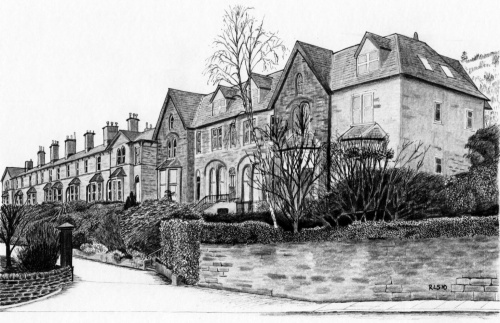
The building was converted into an old peoples’ home, and extended at the near end. The coats of arms in the windows were retained – all except one which had the Baildon lamb on it (it was put into storage in a factory in Halifax and the factory was burnt down). One of those that was retained (three black fleurs de lys on a white background) is that of the Baildon family. The porch on the front of the Town Hall remained all the time it was a nursing home, and was meant to be kept when it was converted into flats but was demolished by the builders. A stone with the Baildon lamb and plough (the old Baildon symbol) was taken to Russell stone yard in Bradford and sold to an unidentified buyer. In 1995 the Butterfield Homes trustees gave permission for the stone to be copied at a cost of £600 and placed in the front of their Home on the Grove.
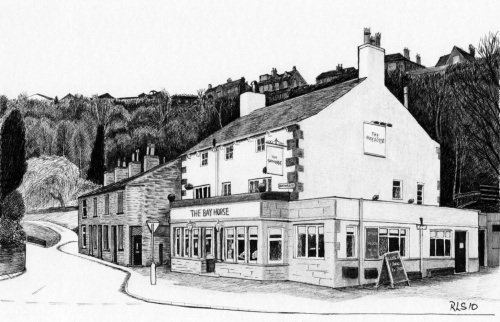
Just above Rushcroft Terrace is Cliffe House Day Nursery, a detached stone house next to Browgate which was the vicarage until 2009, when the new one on Church Hill below the Parish Church was built. Beyond this is Green Road, with some older houses visible along it. Here there used to be a hamlet called Lane Ends, where several ancient lanes met. It was a small community including a farm and some thatched cottages. The refurbished building just above the junction, now converted into several business offices, was until quite recently a pub called The Bay Horse (listed in the 1838 Baines Directory).
Walk back down to the pelican crossing, recross Baildon Road, and turn left and return to the end of Station Road. Cross all these busy roads with due care – it may be wise to walk a little way down the hill before crossing Station Road. Then go back up Baildon Road to the first road on your right, Hallfield Drive, where you can look at Baildon’s war memorial on the corner, containing the names of those men from Baildon who were killed in the two World Wars. There are 144 names of those killed in the first world war and 93 names of those killed in the second. Since then the name of Sapper Jordan Rossi has been added: he was killed in the conflict in Afghanistan in 2009. The bungalow behind is part of the memorial and was originally built for the District Nurse: in 1936 Kelly’s Directory calls it Memorial House, and the nurse who lived there was a Miss Lilly Brown. It is still rented on favourable terms to suitable tenants.

Before you proceed along Hallfield Drive, you might like to walk a little bit farther up Baildon Road hill. Just round the corner is an old filled in horse trough, a relic from the days of horse drawn transport. The house behind the horse trough used to be a chemist’s shop – aptly named the Well Pharmacy.
Having done that, come back down to the war memorial and walk along that side of Hallfield Drive past modern houses until you reach the very old stone building which is Baildon Hall. This is the only Grade II* listed building in Baildon. Late C16th and C17th, there are remains of an earlier timber-framed medieval building to be seen inside, as well as other interesting historic features including an Elizabethan staircase. There is still some wattle and daub infill left from the timber framed building, which was later encased in stone. The wattle and daub is being carefully preserved for future generations to see. The hall has been lovingly restored to show some of its former glory including fireplaces and plaster ceilings. There is much of historic interest to see inside the hall and appointments can be made to visit it (Tel: 01274 598728). The stones in the ornamental wall adjoining the grounds of the hall and the garden of the house next door below the entrance to the rear car park, were brought here from the old Bradford Infirmary, which was on Infirmary Street off Westgate in Bradford.
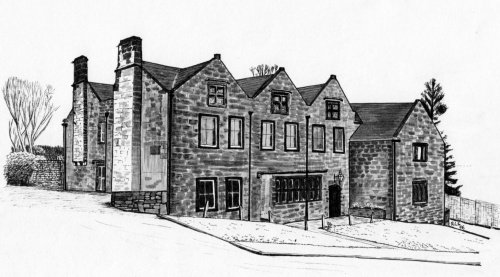
The hall is now a private club but has had several other uses. Until C17th it was the home of the Baildon family, Lords of the Manor of Baildon, whose modern descendants live in Baildon and can trace their ancestry back one thousand years. Baildon was included in the Domesday Book of 1086. At that time some of Baildon was an outlying part of Otley manor and some was in Bingley manor.
Now return along Hallfield Drive to Baildon Road. Turn left round the corner into Station Road. You are going to walk back along Station Road, where there is more to see on this side of the road.
Heading towards the station
When you are opposite Netherhall Park, at the bottom of the dip in the road just where you’d expect to find it, you can see and hear Barnsley Beck. It runs through the garden of the house on your left called Beck Side, built c.2000, and you can just see the beck through the garden gate. Older Baildon residents can remember as children playing in it near here – ‘a beautiful rushing stream’. And under Woodcot Avenue, farther down the hill, it used to flow through a large pipe: one former local resident called Rodney Sykes remembers standing upright in it as a lad. But now this is its only overground appearance after it enters Baildon from the moor: otherwise it flows underground down to the River Aire, which it joins below Charlestown Cemetery. There is more about the lower reaches of the Beck in The Charlie Thompson Walk.
Continue walking along Station Road – noting opposite the good view of Baildon Manor (Beck House) and Hop Butt which we have already passed. Soon you come to Whitelands Road. Nora Dunwell who lived in a cottage at Hop Butt remembered there being a way through from the top of Whitelands Road to Butler Lane (See Baildon Village Walk) before the houses were built which now block the way. There used to be a bridge across the beck behind Baildon Hall. On the Baildon tithe map there are two fields here, called White Lands and White Land. They were owned in 1845/6 by Jane Anne Meek and were grassed. They probably derived their name from a person who once owned them, as the land locally is neither white chalk or limestone but millstone grit or clay.
Cross Whitelands Road, noting the luxuriant (and ancient) rhododendrons at a house built by the Butterfields family, and continue to the top of the rise. You will see a large house called Netherhall (so named because of its closeness to Baildon Hall above). This too was once a doctor’s house: in 1924 a Dr G E Macvie lived there. During the second world war a babies’ nursery was set up in this house – for under-twos, because normal nurseries took only older children – to cater especially for munition factory workers. There was a qualified matron and staff nurse. In fields nearby children could play, and staff pushed prams.
Farther on you come to Borrins Way. In a house called The Borrins (now an old people’s home) there used to live a Bradford woolman called Bateson. Mr and Mrs Bateson were staunch supporters of the Conservative Club, and in the 1950s held friendly garden parties in the field behind their house to raise funds.
After Borrins Way, and the road up to Flower Mount, you will see a low stone detached house with mullioned windows called Crow Trees, which is a Grade II listed building. Built in the 1740s to 50s it was formerly 3 cottages for handloom weavers. In the 1930s and 40s it housed Mrs Nicholson’s school for children of wealthy woolmen. Children from the Waddilove and Reddihough families attended the school. One former pupil Ian Carter, who later moved to Surrey, remembers starting at Mrs Nicholson's school in 1936, and there being four other pupils: Margaret Archer whose father was the vicar at the time, Ruth Reddihough, Jimmy Wrigglesworth and one other. He used to walk to school from his home in Baildon Road, crossing Baildon Road and going down the snicket opposite Glenholm Road, and then across the fields to Station Road. One memory is of standing in the classroom with the windows open to hear the guns, probably in Manningam Park, sounding the start of the two-minutes silence on Remembrance Days. They would walk up the footpath at the side of the school, sometimes with Mrs Nicholson, to see a bird’s nest in the wall. When the school closed, Crow Trees took lodgers, and Mr Bateson lodged there while the Borrins was being renovated.
Crow Trees was part of the Beech Mount estate which the Reddihoughs owned. John Reddihough was one of the millowning millionaires with a business in Bradford who lived in Baildon. One Baildon resident remembers being invited with friends to the big house for tea, it being brought by a maid with a white cap and apron.
When his son Fred Reddihough died in 1963, Fred’s widow gave the big house and grounds to Flower Fund Homes. (She went to live in the newly converted apartments at Rushcroft Terrace – the old Town Hall which we have already seen – paying £300 per week for an entire suite on the top floor.) The Beech Mount land was sold for housing and Crow Trees, in a bad state of repair, was also sold. After a succession of owners it is now owned by the Butler family. The large house formerly known as Beech Mount, now Flower Mount, has survived, and bungalows for the elderly have been built in the grounds. The old building which was built in 1886 is hidden behind trees. (You can walk up the Flower Mount snicket to Church Hill and Baildon village but you can’t see the big house: only the grounds and bungalows are visible.)
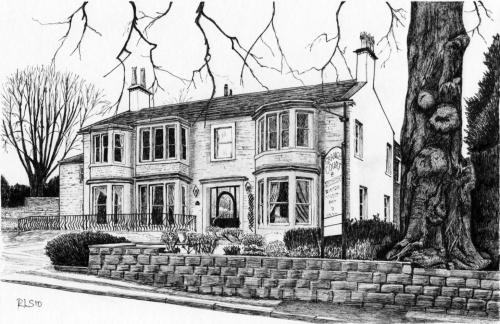
Continue along Station Road (past Brook Hill Stores, opposite, where this walk began). After Plantation Way, and opposite the junction with Kirklands Road, you will pass the high wall in front of Baildon House. From here on, this part of Station Road used to be called Billy Lane. Just beyond Baildon House you will reach a narrow opening on the left which is the old Holden Lane, an ancient way up to Baildon, named after the original inhabitants of Baildon House. It used to be known as Boggart Loin, or Lane, reputedly haunted. In the wall at the corner of Holden Lane there used to be an attractive old cast-iron plaque directing walkers up to ‘The Moors’: that was recently stolen, but has been replaced with an exact copy. This was once a well used walkway from Baildon Village to the station, especially during the second world war when petrol was rationed.
The next house is now a care home for the elderly called Grange Court. The house used to be called Baildon Lodge and at one time Titus Salt junior and his family lived there, before moving to Milner Field. Before that there was a pub on the site called the Leather Breeches.
Langley House and Lodge

Continue past Kirkfields until you reach a road of new houses on your left called Foxstone Rise. Follow that road round. On your left you will see Langley House, an imposing white Grade II listed building. It has a datestone 1877 on the front. This very large house was first owned by the Whiteheads who were wealthy millowners: W.J.Whitehead was one of the millionaires who lived in Baildon at that time. The Waddiloves, another millionaire family, who owned Provident Clothing, owned Langley House later. In the second half of the C20th it became a council-owned special school for children before becoming a private residence again. Langley House is an impressive sight when viewed from the hilly end of Park Mount Avenue, especially at night when it is floodlit (see below for directions).
If you turn right at the end of Foxstone Rise and walk down Fairfield Drive towards Station Road you can see Langley Lodge, also listed, with its datestone WJW 1889 and the cobbled yard and stable block at the bottom on the left.
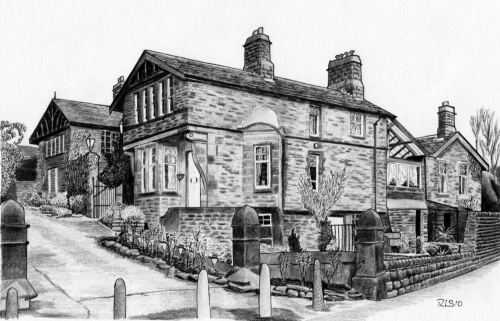
Do not try to cross Station Road here: visibility is far too limited. Return along Foxstone Rise to Station Road. Cross to the other side where there is a footpath and turn left. Continue along Station Road, passing the road, and later the footpath, down to the station on your right.
At the corner, where Station Road becomes Roundwood Road, we reach the extremity of this walk. Visibility is really too restricted to cross the road safely here, but opposite you can see Silson Lane, named after the Silson family, a C17th family of yeomen clothiers. It is an old lane up to Baildon and, like the old Holden Lane we saw earlier, was once much used for pedestrian access to the station – quiet though it looks now.
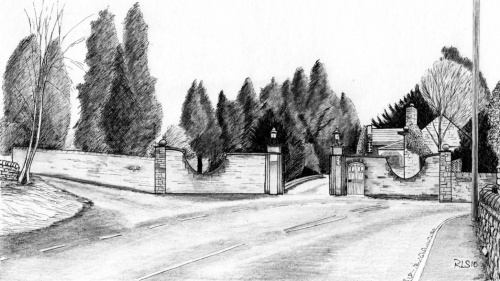
Just to the right of Silson Lane, but approached by a long private drive and thus hidden from view, is Woodlands House, another large old house (converted into apartments in the 1960s) where Joseph Denby of Tong Park lived for a time (see Railway Walk). Built in 1899 in a similar style to Roundwood Grange (see Kirklands Walk) the house and its lodge are now Grade II listed. It was built for George Ambler, of Jeremiah Ambler and Sons (Bradford), who moved to Woodlands from Kirklands House with two sisters, Harriet and Sarah (see Kirklands Walk). In the 1960s land was sold off and houses built in the large grounds.
To return to Brook Hill Stores where this walk began, retrace your steps along Station Road (crossing where you have to, because the pavement changes sides), passing the top of Kirklands Road.
Detour for distant view of Langley House
For those willing to make a small detour for a fine view of Langley House, walk back down Kirklands Road and cross the stone railway bridge (be careful; there is no pavement). Walk across the end of Kirklands Lane and up the steep little hill which curves up and round on Park Mount Avenue. From the top looking back you will have a magnificent view in the distance on your right of the very large white Langley House. It is floodlit at night.
Retrace your steps up Kirklands Road to Brook Hill Stores where this walk began. (Alternatively, to reach the station from here, recross the railway bridge and turn right into a snicket by some flats. Continue round these and turn left along Ridgewood Close, parallel to the railway line which you will see on your right. Continue to the station car park and the platform.)
Note about distances
Distances quoted were measured from Google maps using their distance measuring tool. The figures should be regarded as approximate and very much a minimum because you will undoubtedly walk farther, looking at this and that.